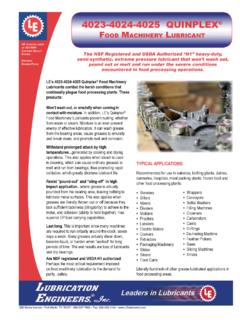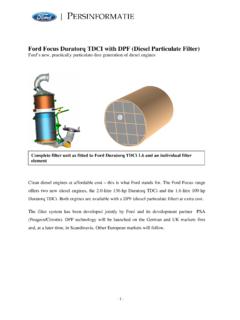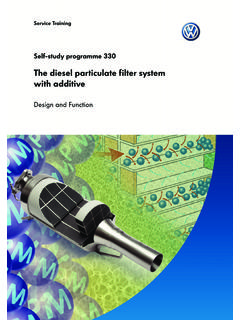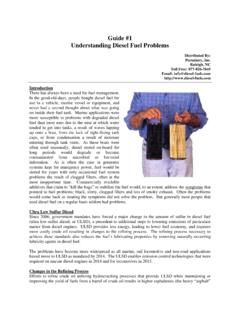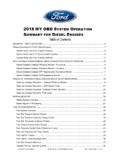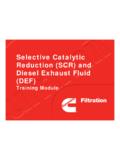Transcription of DIESEL FILTER DIRT HOLDING CAPACITY - lubeng.com.au
1 1 DIESEL FILTER dirt HOLDING CAPACITY The Misleading Factor 2015 Bradley Crook, Lubrication Engineers Pty Ltd. ALL RIGHTS RESERVED 2D I E S E L F I L T E R D I R T H O L D I N G C A P A C I T Y 1. Abstract The DIESEL fuel FILTER business is a multi-billion dollar industry with hundreds of manufacturers around the world producing a wide variety of products for contamination control in DIESEL engines and for bulk storage and dispensing applications. Competition to produce these filters and gain a slice of this lucrative market is extremely high and as such, manufacturers are continually striving to gain a competitive edge; be it through product innovation or sales and marketing strategies. One of the more popular strategies of recent times is to advertise the dirt - HOLDING CAPACITY of the FILTER element, simply represented as total weight in grams or ounces.
2 This paper is intended to provide an insight into this widely used reference factor and will explore the reasons why the average consumer should avoid using such information as a standalone determining factor for FILTER selection or as a predictor of actual FILTER service life. 2. Introduction Various FILTER element manufacturers use and report dirt - HOLDING CAPACITY data as a method for advising consumers how well a FILTER performs its function. This is mainly because it is very easy for the everyday person to interpret the information. If two filters look the same and one holds more dirt than the other, it should be relatively easy to determine which is the better value for money. On the surface this would be a logical determination, however due to the variations in tests being used to obtain dirt - HOLDING capacities, relying on such information as a standalone determinant is fraught with danger.
3 When reviewing the dirt - CAPACITY of a DIESEL fuel FILTER element, it is important to know which test has been used to obtain the information and how that test was conducted. Even then, the information is not always useful or relevant to the specific application. Despite uniformly more stringent FILTER test methods, there remains some inconsistencies in both the gathering and reporting of data. 2015 Bradley Crook, Lubricare Pty Ltd. ALL RIGHTS RESERVED 3D I E S E L F I L T E R D I R T H O L D I N G C A P A C I T Y 3 The History of Testing The reporting of FILTER element dirt - HOLDING capacities has steadily increased since its rise to popularity during the 1980 s. Such an increase was primarily the result of an explosion in FILTER element competition following the release of advanced 3 m ( 3 200) FILTER elements into the market during that period.
4 These FILTER elements quickly gained in popularity as they targeted and significantly reduced the fine silt contaminants that were causing new electrohydraulic servo proportional hydraulic valves to fail. In order to gain a competitive edge, leading FILTER element manufacturers looked at new methods of marketing the benefits of their product verses the competition; dirt - HOLDING CAPACITY being one such option available to them. The reporting of dirt - HOLDING CAPACITY information originally came from the ISO4572 Multi-pass test standard developed by International Standards Organization (ISO). Hydraulic FILTER elements tested under this method were evaluated on their ability to separate contaminants of certain sizes from a fluid and under specific operating conditions. Filtration performance was measured by analyzing three areas: 1.
5 Efficiency or absolute rating and percent efficiency 2. dirt HOLDING CAPACITY (DHC) 3. The pressure drop across the element at a specific absolute efficiency. The ISO4572 test required that a known and predefined test contaminant - AC Fine Test Dust (ACFTD), be added to the test system until the FILTER element terminal differential pressure ( P) was reached. Following the test, the volume of test contamination added to the test system was recorded. This data became known as Apparent dirt - HOLDING CAPACITY . However, as the ISO4572 standard did not specifically demand filtration manufacturers or laboratories to advise how the data was to be presented to the consumer, many manufacturers simply advertised the data as the dirt - HOLDING CAPACITY leaving out the word Apparent.
6 As might well be understood, the volume of contamination added during the test cycle has little or nothing to do with the actual volume of contamination retained by a test FILTER . 2015 Bradley Crook, Lubricare Pty Ltd. ALL RIGHTS RESERVED 4D I E S E L F I L T E R D I R T H O L D I N G C A P A C I T Y Reporting this information in such a way gave the consumer false and misleading information about the filters real ability to retain contamination. There are some products available today that still represent data in this manner. The ISO4574 test method is no longer used as the AC Rochester Division of General Motors Corporation ceased manufacturing the test dust during the late 1990 s. Test procedures have changed considerably as have the test dusts that are used to obtain dirt - HOLDING CAPACITY information.
7 4 Current Test Procedures The popular view held by many is that the dirt - HOLDING CAPACITY of a FILTER should be a relatively easy factor to determine; surely the FILTER element is tested according to a known method or standard, drained and then weighed to see how much contamination has been captured? However, this could not be further from the truth. FILTER elements, including DIESEL fuel filters are NEVER weighed following a test in order to determine the actual retained dirt - HOLDING CAPACITY . Tests used today require a series of complex calculations to be completed in order to accurately assess the effective dirt - HOLDING CAPACITY of a FILTER . Figure 1 represents one of the calculations used for dirt - CAPACITY . There are three common test methods used today by most manufacturers to obtain and report the dirt - HOLDING CAPACITY of a DIESEL fuel FILTER .
8 This includes fuel filters used in engine applications and those that are used in large bulk transfer and fuel bowser applications. The common test procedures are as follows: 1. ISO16889: 2008 Hydraulic fluid power Filters Multi-pass method for evaluating filtration performance of a FILTER element Figure 1: Typical dirt - HOLDING CAPACITY calculation 2015 Bradley Crook, Lubricare Pty Ltd. ALL RIGHTS RESERVED 5D I E S E L F I L T E R D I R T H O L D I N G C A P A C I T Y 2. ISO19438: 2003 DIESEL fuel and petrol filters for internal combustion engines Filtration efficiency using particle counting and contaminant retention CAPACITY 3. SAEJ905: 2009 Surface Vehicle Standard Fuel FILTER Test Methods Times have changed in the way that dirt - HOLDING CAPACITY data is reported, however even today with these more stringent methods in place, the terminology used in the reporting of the data can be somewhat misleading.
9 In most cases, the dirt - HOLDING CAPACITY of a FILTER tested today is known as Retained CAPACITY . Again it is important to note that the FILTER is not weighed to determine how much contamination is actually retained. The definition of Retained CAPACITY is as follows: mass of the specific particulate contaminant effectively retained by the FILTER element when the terminal element differential pressure is reached The word effectively has been highlighted to reinforce that the data is a calculated number rather than an actual weighed dirt CAPACITY . ISO16889:2008 Most fuel filters used in bulk DIESEL filtration and bowser applications use this test method for measuring dirt - HOLDING CAPACITY . When reviewing the dirt CAPACITY of a FILTER element or comparing products to each other, the following should be considered in relating to this test method.
10 This test method is a multi-pass test designed specifically for testing the efficiency rating of hydraulic filters. A bulk DIESEL fuel filtration application is almost exclusively a single-pass proposition, meaning that the FILTER has one chance to capture contaminants. Testing the FILTER under this test method gives the FILTER multiple chances at capturing the contaminants. The method states that: This test is intended to differentiate FILTER elements according to their functional performance but is not intended to represent performance under actual field operating conditions . 2015 Bradley Crook, Lubricare Pty Ltd. ALL RIGHTS RESERVED 6D I E S E L F I L T E R D I R T H O L D I N G C A P A C I T Y The method uses ISO12103-1-A3 Medium Test Dust (ISOMTD).
